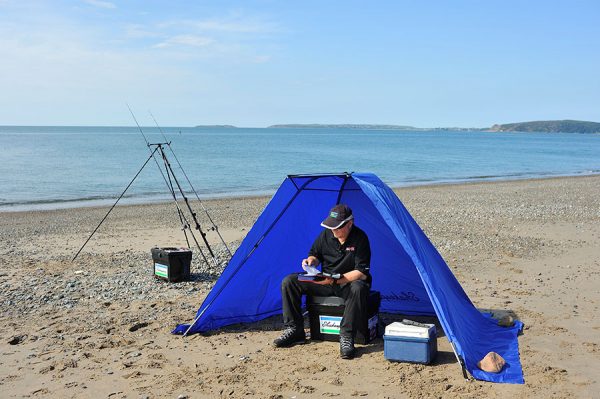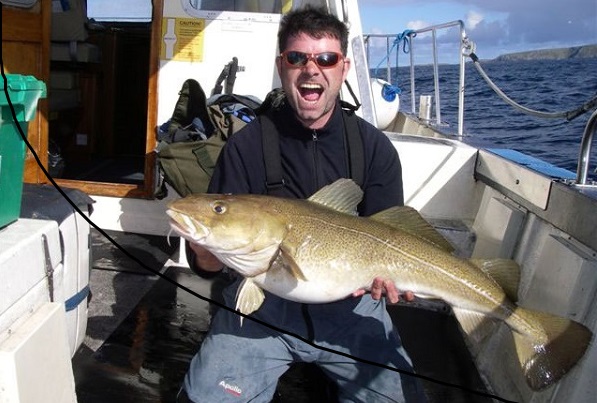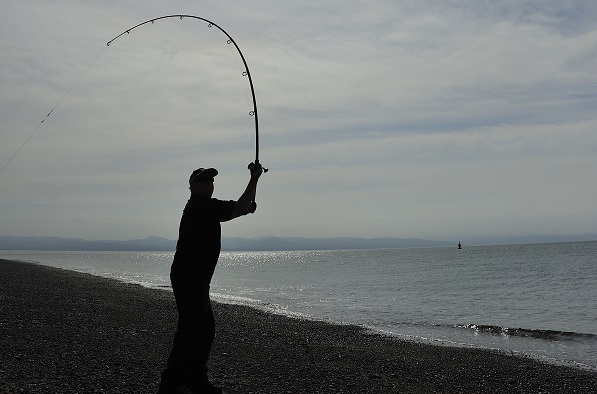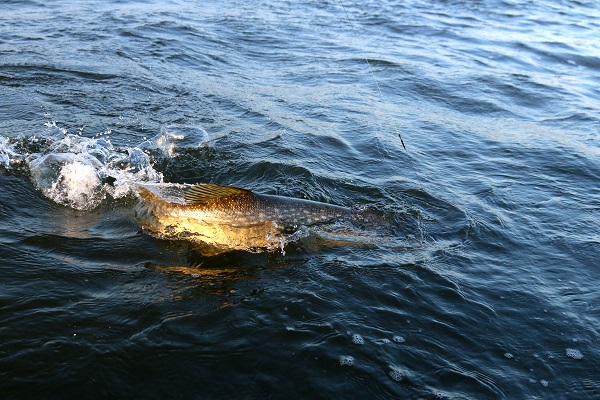Britain’s favourite sea fish species, the cod, has arrived around our coast, so don’t miss the opportunity to catch your share of the bounty. It’s time to prepare for your assault for cod, but fishing for the nation’s favourite fish is surrounded by myth and fiction, so the degree to which you get caught up in the hype depends on enthusiasm and experience.
The cod season in many regions starts much earlier than lots of sea anglers realise; August and September may see codling moving inshore. Shorter daylight hours and falling temperatures are nature’s way of telling the cod that winter is approaching and that it is time to move inshore to feast on the marine bounty. For example, the aftermath of an autumn or winter storm offers huge feeding opportunities.

BE VERSATILE
Another important decision at the start of the cod season is venue selection. Most anglers like to fish their local beach or pier and wait for the cod to arrive, but this can be very hit and miss. Cod around the UK fluctuate in size and numbers every year according to their previous spawning success, so while one region may struggle to produce, another will not. The answer is to travel, but it is amazing how many anglers still prefer six biteless hours on a local venue when half that time spent visiting elsewhere could see them catch cod.
Cod shoals dwindle in numbers as the fish increase in size, so it is important to realise that catching a fish over 6lb is never easy. Small codling grow rapidly and, as they do so, their appetite increases, and at 5-6lb they move out to sea and feed solely on other fish. Only in the dead of winter, after an onshore gale, are the bigger cod tempted to return inshore. It is noticeable that this happens in regions where cod are plentiful and the competition for food is strong. Where there are fewer cod, they have no need to move inshore in search of food, whatever the weather. Therefore, to succeed from the shore in autumn and winter you need to be versatile, with the ability to tell fact from fiction, and a willingness to go where the fish are. Cod are fish of habit, and through the generations they will visit the same venues at the same time and state of tide. Even if you miss out on one of these occasions when everything comes together, make a note of when these favourable conditions are likely to reoccur because the cod will be back, and next time you can be there when they arrive.
GEAR UP FOR SUCCESS
Any beachcaster rated to cast from 5oz upwards can be used to catch virtually any UK sea species, including cod. However, many winter cod anglers, who are seasoned to the worst conditions, opt for more powerful rods rated between 6oz and 8oz, or even up to 10oz. Autumn and winter cod fishing is often about fishing in a weed-filled, surging surf or swell, and strong tides with large bait loads; it is not for the soft, summer mackerel rod or overhead cast.
Shakespeare Telescopic Omni Spinning Rod
from £19.99Shakespeare Omni Spin
from £32.99from £35.99Shakespeare Sigma Supra Beachcaster Rod
from £49.97from £59.99Penn Rampage II Bass Rod
from £109.99from £114.99Penn Squadron II SW Spin
from £59.99from £64.99Shakespeare Agility 2 Long Surf
from £94.99from £109.99
Rocks and weed demand a stiffer, more powerful blank to bully fish or to break out tackle from the seabed, while clean-ground fishing in a big sea still demands a rod that can blast a bait through any weather, and many choose the longer lengths up to 16ft. Remember, too, that some rods are labelled as 6oz, but this does not always take into account the rig, lead weight and bait, which could weigh as much as 1lb. Using two rods is almost standard among cod anglers. A pair of tips in a tripod can be compared against each other when watching for bites and, most importantly, using two rods ensures that you have a bait in the water all of the time.
A solid, firm, adjustable aluminium tripod with leg braces is a must on a stormy beach to keep your rod stable and the tip high above the waves. A twin head and butt cup set can be used to raise the rod tip and line well above the swell and weed. It can prove invaluable when the sea is rough. Look for the adjustable height style of butt cup.
REEL CHOICE
Reels, too, tend to be designed for long-range casting because distance is so important to the shore-based cod angler. Multipliers (6500 or 7000 size) contain ball-bearings and magnetic brakes, and the fixed spools have profiled spools and improved cranking power. The multiplier with magnetic brakes is an easy reel to master. On all models the adjustment of the supplied magnets is sufficient to suit winter beach fishing. Most perform best with 15lb (0.35mm) line, while the larger models, like the Penn 525, are easier to use with 18lb (0.38mm) line. It can be wise to start out with 18lb or 20lb, whatever model you decide to choose.
Abu Garcia Ambassadeur C-7000
from £109.99from £119.99Penn MAG3
from £139.99from £169.99Daiwa Sealine SLOSH Multiplier
from £79.97from £160.00Abu Garcia Ambassadeur 6500 Power Handle
from £69.97from £139.99Penn Fathom II Star Drag
from £159.99Shakespeare Omni Multiplier
from £39.99
Reels must be loaded correctly. You need an efficient working diameter and line load, not as much as you can cram on, or of an overlarge diameter. Most casting multipliers work efficiently with 250-300 metres of 0.35mm (15lb). Lighter lines (0.32mm, 12lb) are for the best casters and clean ground, while slightly heavier (0.38mm, 18lb) line is best for the less experienced and over mixed ground.
Penn Pursuit III
from £61.99from £69.99Shakespeare Agility 2 Saltwater Spin FD
from £47.99from £54.99Penn Battle II LC
from £109.97from £139.99Penn Battle II Spinning Reel
from £74.97from £89.99Shakespeare Agility Surf Reel
from £49.99from £64.99Penn Spinfisher VI Spinning
from £119.99from £139.99
Modern, profiled fixed-spool spools allow far lighter lines to be used (8-12lb), which makes them ideal for braid line and fishing rough ground. Improved gearing means these reels no longer lack lifting power. Remember, casting with a fixed-spool reel is improved with the use of some finger protection (finger stall), and this is important when using braid. When choosing a fixed-spool reel, the 9000 sizes are the best for beachcasting. Load them to the lip because, unlike multipliers, they perform best with a full spool.
BE SURE TO CARRY YOUR SPARES
The loss of a shockleader puts a reel out of action until another leader is tied, and if some of the mainline is lost, the reel is ruled out. It’s why spare reels are essential, and offer the best solution for lost tackle or leaders because they can be replaced by the spare inside a few minutes. You can then tie on a new leader, or reload with line, while you continue to fish. In some rough-ground situations, it is worth considering a larger model loaded with a heavier line, so you can dispense with the weaker leader joint. Tapered leaders are an excellent option if you want to replace a leader on the beach in a hurry; use a double blood knot as a strong alternative to the uni-knot.
GUIDE TO THE ACCESSORIES: COMFORT IS A PRIORITY
Cod move close to the shoreline under cover of darkness, and winter offers the most suitable tides and weather conditions for the sea angler. Remember that a short, prime tide night session, when you decide on the times and venue beforehand, will always be more productive than a random fishing marathon. Comfort is a priority, but, fortunately, there is a wide choice of wet-weather and thermal gear. Go for a two-piece suit of the bib-and-brace trousers type with a separate jacket, which allows you to adjust to the temperature, whereas a one-piece suit does not. A hood or high collar keeps the breeze out. On long, low-water marks, nothing beats a set of chest waders and a waterproof smock to keep you dry and mobile. Other aids to comfort include gloves, a hat, the essential flask with a hot drink, and a dry towel.
ProLogic Max5 Comfort Thermo Suit
from £100.00from £159.99IMAX Thermo Suit
from £84.99from £129.99Daiwa Match Winner Two Piece Suit
from £69.97from £110.00ProLogic HighGrade Thermo Suit
from £79.99from £129.99IMAX ARX-20 Ice Thermo Suit
from £99.99from £139.99IMAX SeaWave Floatation Suit
from £119.99from £169.99
BASE CAMP
Once your clothing is sorted, you may want some form of shelter. A Beach Buddy-type shelter takes some beating. It’s good to have a dry bolthole for yourself, your tackle box and bait. Brollies with skirts are easy to erect in wind if you need to move several times with the tide.
It’s wise to put up your shelter well above the high-water mark with its back to the wind. Common sense really, but in a strong wind the sides can bow in, and it could even take off. Positioning one of the corners into the wind prevents this. Most shelters benefit from being well anchored with beach stones, plastic bags full of sand, or even your tackle box and a fish bucket full of water. Place your rod-rests at the front of the beach, not so close to the shelter that it gets in the way. A twin head/cup model offers the advantage of comparing rod tips, which does make spotting bites easier.

Angle any lighting to the rod tips and position your seat box to give maximum shelter from wind or rain. Spare rods can be kept behind the shelter in a lightweight monopod. If you are using two rods, always fish the shorter casting of the pair on the uptide side. The same goes for anglers fishing close together with one rod each.
LIGHTING
Almost all the latest fishing headlamps are LEDs with specialist beams and longer lasting batteries. Whichever model you choose, consider the fit and adjustment of the head strap – those on some of the cheaper lamps will twist and lose their elasticity. Also consider the weight of the batteries – one big advantage of the LED is that battery life is long, so smaller, lighter batteries can be used. Winter weather and saltwater can catch headlamps out, so it’s wise to carry a back-up. One of the cheapies can be a saviour if your main light fails. Besides LEDs, there are larger, brighter base lamps, like those used by carp anglers, and these are great for anyone fishing near the car park. Fuel pressure lanterns are another option.
Fox Halo MS250 Headtorch
from £37.99Petzl Tikkina Headlamp
from £25.00ESP Bank Lamp
from £18.99Fox Halo 200 Headtorch
from £24.99Petzl Tikka 200 Lumen Headlamp
from £34.97from £34.99Fox Halo AL350C Headtorch
from £59.99from £64.99
Now you have a better understanding of cod fishing setups, why not check out our article on our Top 3 Cod Fishing Rigs.





































